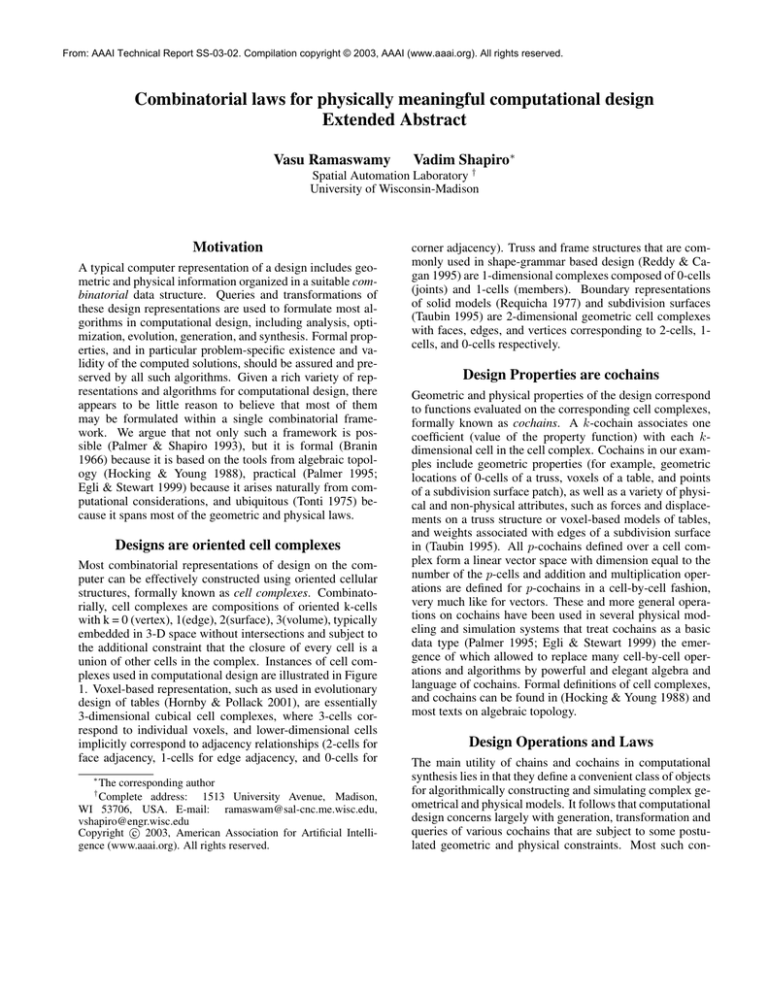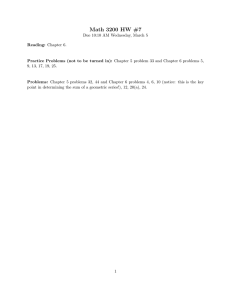
From: AAAI Technical Report SS-03-02. Compilation copyright © 2003, AAAI (www.aaai.org). All rights reserved.
Combinatorial laws for physically meaningful computational design
Extended Abstract
Vasu Ramaswamy
Vadim Shapiro∗
Spatial Automation Laboratory †
University of Wisconsin-Madison
Motivation
A typical computer representation of a design includes geometric and physical information organized in a suitable combinatorial data structure. Queries and transformations of
these design representations are used to formulate most algorithms in computational design, including analysis, optimization, evolution, generation, and synthesis. Formal properties, and in particular problem-specific existence and validity of the computed solutions, should be assured and preserved by all such algorithms. Given a rich variety of representations and algorithms for computational design, there
appears to be little reason to believe that most of them
may be formulated within a single combinatorial framework. We argue that not only such a framework is possible (Palmer & Shapiro 1993), but it is formal (Branin
1966) because it is based on the tools from algebraic topology (Hocking & Young 1988), practical (Palmer 1995;
Egli & Stewart 1999) because it arises naturally from computational considerations, and ubiquitous (Tonti 1975) because it spans most of the geometric and physical laws.
Designs are oriented cell complexes
Most combinatorial representations of design on the computer can be effectively constructed using oriented cellular
structures, formally known as cell complexes. Combinatorially, cell complexes are compositions of oriented k-cells
with k = 0 (vertex), 1(edge), 2(surface), 3(volume), typically
embedded in 3-D space without intersections and subject to
the additional constraint that the closure of every cell is a
union of other cells in the complex. Instances of cell complexes used in computational design are illustrated in Figure
1. Voxel-based representation, such as used in evolutionary
design of tables (Hornby & Pollack 2001), are essentially
3-dimensional cubical cell complexes, where 3-cells correspond to individual voxels, and lower-dimensional cells
implicitly correspond to adjacency relationships (2-cells for
face adjacency, 1-cells for edge adjacency, and 0-cells for
The corresponding author
Complete address: 1513 University Avenue, Madison,
WI 53706, USA. E-mail: ramaswam@sal-cnc.me.wisc.edu,
vshapiro@engr.wisc.edu
c 2003, American Association for Artificial IntelliCopyright gence (www.aaai.org). All rights reserved.
∗
†
corner adjacency). Truss and frame structures that are commonly used in shape-grammar based design (Reddy & Cagan 1995) are 1-dimensional complexes composed of 0-cells
(joints) and 1-cells (members). Boundary representations
of solid models (Requicha 1977) and subdivision surfaces
(Taubin 1995) are 2-dimensional geometric cell complexes
with faces, edges, and vertices corresponding to 2-cells, 1cells, and 0-cells respectively.
Design Properties are cochains
Geometric and physical properties of the design correspond
to functions evaluated on the corresponding cell complexes,
formally known as cochains. A k-cochain associates one
coefficient (value of the property function) with each kdimensional cell in the cell complex. Cochains in our examples include geometric properties (for example, geometric
locations of 0-cells of a truss, voxels of a table, and points
of a subdivision surface patch), as well as a variety of physical and non-physical attributes, such as forces and displacements on a truss structure or voxel-based models of tables,
and weights associated with edges of a subdivision surface
in (Taubin 1995). All p-cochains defined over a cell complex form a linear vector space with dimension equal to the
number of the p-cells and addition and multiplication operations are defined for p-cochains in a cell-by-cell fashion,
very much like for vectors. These and more general operations on cochains have been used in several physical modeling and simulation systems that treat cochains as a basic
data type (Palmer 1995; Egli & Stewart 1999) the emergence of which allowed to replace many cell-by-cell operations and algorithms by powerful and elegant algebra and
language of cochains. Formal definitions of cell complexes,
and cochains can be found in (Hocking & Young 1988) and
most texts on algebraic topology.
Design Operations and Laws
The main utility of chains and cochains in computational
synthesis lies in that they define a convenient class of objects
for algorithmically constructing and simulating complex geometrical and physical models. It follows that computational
design concerns largely with generation, transformation and
queries of various cochains that are subject to some postulated geometric and physical constraints. Most such con-
Surface Fairing
(a)
(b)
(c)
Figure 1: Common examples of combinatorial structures used in computational synthesis; each is an instance of an oriented
cell complex.
straints can be characterized as compositions of topological
and metric laws (Tonti 1975).
Topological relations can be formulated using strictly
topological operations on cochains, such as coboundary δ
that maps k-cochains into (k + 1)-cochains. Examples of
topological laws include geometric integrity, balance, equilibrium, compatibility, and conservation. One of the advantages of using δ to formulate physical laws is that it applies
to any and all cell complexes. For example, assuming that
the cells of the voxel-based table design example are endowed with physics of solid mechanics, the body force F
(or 3-cochain) of each 3-cell is balanced by the resistive traction forces S (or 2-cochain) on its incident 2-cells. The force
balance can be compactly written as F = δS.
Metric laws often specify measured or weighted relationships between a k-cochain and a dual (n − k)-cochain associated with the dual of the cell complex. The common
examples of such laws include Ohm’s law, Hooke’s law, and
other constitutive relationships.
A wide variety of broadly applicable laws may be constructed by combining the primitive measure dependent and
topological laws. That many of these laws follow similar
patterns has been observed by many, notably (Roth 1955;
Branin 1966). As shown in (Tonti 1975; 1999), most physical laws may be represented in a factored form as a composition of the primitive topological and measured relationships. Efforts to develop an interactive geometric language
for describing, combining, and editing combinatorial laws
are currently under way (Chard & Shapiro 2000). The factored form of physical laws may be also used directly to
formulate, compare, and improve various numerical discretization and solution schemes (Hyman & Shashkov 1997;
Mattiussi 2000). Furthermore, the same approach may be
used to represent and enforce a variety of synthetic or userdefined laws, relations, and constraints. An even greater variety of laws may be constructed using operators proposed
by (Palmer 1995) and (Egli & Stewart 1999), though their
properties have not been studied formally.
Future Directions
Reformulating design representations and algorithms in algebraic topological terms introduces a non-trivial concep-
tual overhead, but this additional investment is well worth
it. The most immediate benefit is a unifying combinatorial framework for computational design and an algorithmic toolbox for constructing a variety of laws and invariants. The combinatorial representation is standard in that it
is a straightforward extension of the current geometric modeling practices and systems. The proposed formulation of
laws and invariants is broadly applicable across diverse design domains and computer representations. Implementation should be practical because the primitive laws are quite
simple. Thus, a promising direction for future research is to
reformulate the common techniques of computational synthesis (including L-systems, shape grammars, genetic algorithms, and subdivision) in terms of law-preserving transformations on algebraic topological chains and cochains.
References
Branin, F. H. 1966. The algebraic-topological basis for
network analogies and the vector calculus. In Proceedings
of the Symposium on Generalized Networks, volume 16,
453 – 491. Brooklyn, New York: Polytechnic Institute of
Brooklyn.
Chard, J. A., and Shapiro, V. 2000. A multivector data
structure for differential forms and equations. IMACS
Transactions, Mathematics and Computers in Simulation.
Egli, R., and Stewart, N. 1999. A framework for system
specification using chains on cell complexes. ComputerAided Design 31(11):669–681.
Hocking, J. G., and Young, G. S. 1988. Topology. Dover.
Hornby, G. S., and Pollack, J. B. 2001. The advantages
of generative grammatical encodings for physical design.
Congress on Evolutionary Computation 600–607.
Hyman, J., and Shashkov, M. 1997. Natural discretizations
for the divergence, gradient and curl on logically rectangular grids. International Journal of Computers and Mathematics with Applications 33(4):81–104.
Mattiussi, C. 2000. The finite volume, finite element, and
finite difference methods as numerical methods for physical field problems. Advances in Imaging and Electron
Physics (P. Hawkes, Ed.) 113:1–146.
Palmer, R., and Shapiro, V. 1993. Chain models of physical
behavior for engineering analysis and design. Research in
Engineering Design 5:161–184.
Palmer, R. S. 1995. Chain models and finite element analysis: An executable chains formualtion of plane stress. Computer Aided Geometric Design 12:733–770.
Reddy, G., and Cagan, J. 1995. An improved shape annealing algorithm for truss topology generation. ASME Journal
of Mechanical Design 117(2(A)):315–321.
Requicha, A. A. G. 1977. Mathematical models of rigid
solid objects. Tech. Memo 28, Production Automation
Project, University of Rochester, Rochester, NY.
Roth, J. P. 1955. An application of algebraic topology to
numerical analysis: On the existence of a solution to the
network problem. Proc. Nat. Acad. Sci. 41:518–521.
Taubin, G. 1995. A signal processing approach to fair
surface design. Siggraph ’95 Conference Proceedings 351–
358.
Tonti, E. 1975. On the Formal Structure of Physical Theories. Milan: Istituto Di Matematica Del Politecnico Di
Milano.
Tonti, E. 1999. Finite Formulation of Field Laws. unpublished.

